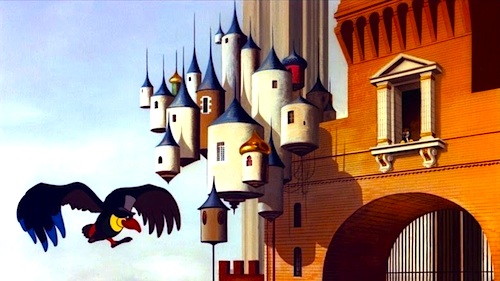By Joe Bendel. It is loosely based Hans Christian Andersen’s The Shepherdess and the Chimney Sweep, but it includes elements of dystopia and steampunk long before they were cool. When production began in 1948, it was supposed to be France’s first animated feature (and it sort of was), yet it would take three decades for it to be completed to its creators’ satisfaction. You might think you have seen it, but if you have only seen the unfinished cut released by the producer under the title The Curious Adventures of Mr. Wonderbird, you really haven’t seen Paul Grimault’s complete and restored The King and the Mockingbird, which had a special screening at the 52nd New York Film Festival, in advance of its premiere American release this November.
In the kingdom of Takicardia, it is good to be the king, at least until the tyrannical Charles V + III = VIII + VIII = XVI is deposed by his own portrait come to life. However, the monarch is so unpopular and self-absorbed, nobody notices the change. He is not the only painting at large in the towering palace. The Shepherdess and her true love, the Chimney Sweep, have escaped the walls of the King’s private quarters to escape her forced marriage to the King’s portrait. They will find a resourceful ally in the Mockingbird, who rather resents the King’s attempts to hunt his young hatchlings. Fortunately, Charles V etc. is a blasted poor shot.
Written by Grimault and celebrated poet-screenwriter Jacques Prévert, Mockingbird is a kitchen sink movie that includes disparate elements, such as the Metropolis-like castle, with the King perched up top and the proles buried down below. There is also a trenchant commentary on personality cults, most vividly realized in the steampunky factory, a veritable mass of gears, cranking out busts of the despised king. Grimault even delivers a kaiju fix when the King’s portrait unveils his secret weapon: a giant killer robot.
Yet, most importantly, Mockingbird is great fun, featuring a sly sense of humor and a gentle, pure-hearted sensibility. There are some pretty profound stakes in the film, but it is never too intense for young tykes. In fact, the Mockingbird is a wonderfully reassuring father-figure, in addition to being an anarchic rebel.

Grimault’s animation is also pure joy to drink in. He inks some striking visuals, especially the action sequences set on precarious ledges around the castle exterior. However, there is an elegant simplicity to his hand drawn figures that is refreshingly nostalgic. While viewers can occasionally see the seams where the work from various years has been married together, the restoration gives it all a nice, clean spit polish.
Grimault’s definitive Mockingbird represents quite a tenacious victory for artistic integrity and creative control. Decades after it was completed for the final time, it still feels oddly contemporary, while evoking the joys of old school animation. Enthusiastically recommended for all ages, the complete and restored The King and the Mockingbird returns to the Elinor Bunin Monroe Film Center on November 21st, following its special screening at this year’s NYFF.
LFM GRADE: A+
Posted on October 11th, 2014 at 2:45pm.